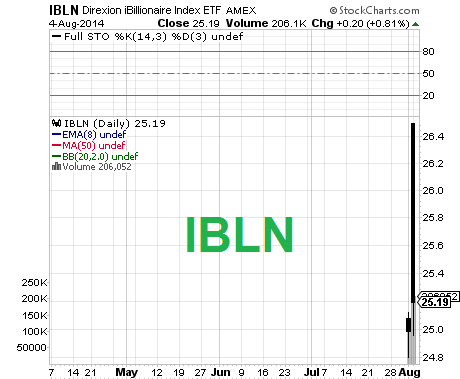- The Direxion iBillionaire Index ETF (NYSEARCA:IBLN) tracks the iBillionaire Index comprising 30 U.S. large- and midcap securities favored by the richest and most successful investors, such as Warren Buffett, Carl Icahn and George Soros, as stated in 13F filings.
- It competes with the Global X Guru ETF (NYSEARCA:GURU) for assets, as GURU also attempts to mimic equity positions taken by large hedge funds; however, IBLN will feature a cheaper expense ratio of 0.65%, which could help attract investors.
- Other ETFs which track the holdings of well known investors: GURX, GURI
click for live IBLN 3-month chart (Yahoo)
The index uses the billionaires lists produced by both Bloomberg and Forbes to identify 20 or so U.S.-based billionaire investors. (So no Bill Gates or Walton family members.) It then picks the top 10 billionaires by performance. It judges performance by looking at filings called 13Fs that investors overseeing more than $100 million in U.S. equities must file with the Securities and Exchange Commission. The filings, due within 45 days of the end of a quarter, list equity holdings that trade on U.S. exchanges. The 30 stocks where the investors have the most combined money becomes the ETF's index, which is rebalanced quarterly.
For example, in the 13Fs for 2014's first quarter, Apple Inc. (APPL) was the big money's favorite stock. It made up 16 percent of Einhorn's reported holdings, 12 percent of Icahn's, 8 percent of hedge-fund manager David Tepper's and just under 1 percent of George Soros's. The next most popular stock was Micron Technology Inc. (MU), with a combined exposure of 16.8 percent, and Priceline Group Inc. (PCLN), at 14 percent. The 30 stocks are equal-weighted, with each one making up 3.3 percent of the index.
If this sounds a lot like the Global X Guru Index ETF (GURU), that's because it is. There are a few differences. IBLN only looks at large-capitalization U.S. stocks while GURU, which has $500 million in assets, will look at small- and mid-cap stocks and some international. This should make IBLN less volatile than GURU, which rose 48 percent in 2013, outdoing the S&P 500 Index's 32 percent. So far this year, with the performance of small-caps and momentum stocks cooling, GURU is up 2 percent to the S&P 500's 8 percent.
So far this year -- in theory, since the index wasn't live -- the iBillionaire Index is up 7.7 percent, compared with GURU's 2.3 percent. However, in the past two momentum-driven years, GURU has a slight edge, returning 75 percent to IBLN's 67 percent. IBLN will charge 0.65 percent of assets annually, slightly less than GURU's 0.75 percent.


No comments:
Post a Comment